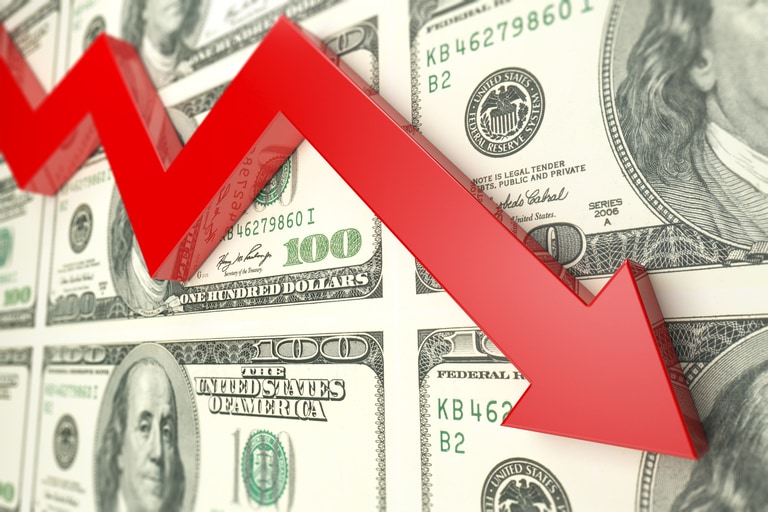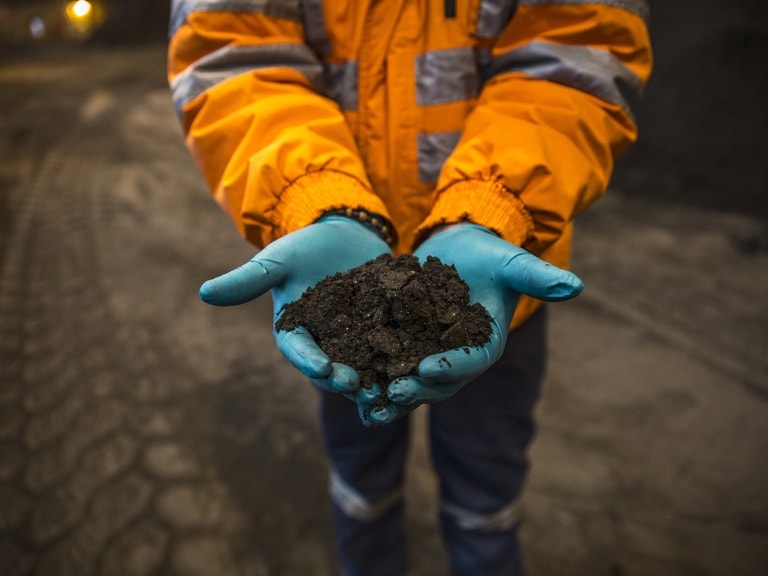Read our pick of the top stories to look out for in the coming week (25-29 October), and view our key company earnings schedule.
In this week's video, Michael discusses Thursday's ECB rate meeting, rising inflation, the UK's autumn Budget, and the latest numbers from Lloyds, NatWest, HSBC, Apple, Facebook and Microsoft, among others.
MONDAY 25 OCTOBER
HSBC Q3 results
Although HSBC’s half-year results, announced in August, revealed a doubling of pre-tax profit compared to the first six months of 2020, it was notable that revenue fell 4.5% from the year-ago period, which may partly explain the underwhelming share price reaction. Compared to its UK peers, HSBC’s share price has underperformed, although it's improved in recent weekst. A lot of the underperformance, particularly in Q2, was probably due to concerns about HSBC’s Asia business, and worries about its exposure to the Chinese property sector, and wider Chinese economy, as crackdowns on various business sectors have contributed to a sharp slowdown in economic activity across the country.
Since the lows in September, HSBC's share price has rebounded over 10%, and while they are in positive territory for the year to date, they are still below May highs. Those peaks came after the release of its Q1 numbers in April, which saw the UK’s largest bank report profit after tax of $4.6bn, mostly thanks to its Asia business. Q1 was also helped by the bank releasing $400m of the $8.8bn set aside in 2020 for potential loan losses during the pandemic. Management cited an improvement in the economic outlook of its UK business as part of the reason for the return to profit, with mortgages doing particularly well. The bank’s UK arm generated profit of $1bn in Q1 and a further $1.1bn in Q2, partly because of this improved demand. In Q2, HSBC’s profit after tax improved again, coming in above expectations at $3.9bn, despite lower revenue. The headline numbers were helped by the bank releasing a further $300m from provisions for non-performing loans. After-tax profit for the first six months of the year totalled $8.4bn, as the bank announced an interim dividend of $0.07 a share. The 4% decline in revenue was largely down to lower interest margins across the bank’s global operations, which fell from 1.43% a year ago to 1.21%. In common with its peers, HSBC reported a decent increase in lending – up $21.5bn – in the first half of the year.
In light of the strong performance of the major US banks, the main focus for HSBC's Q3 will be whether the various problems in China’s property sector, particularly the Evergrande fallout, have had a material impact on its business, or whether the actions to limit its exposure have had a material cost. Other considerations will be whether the bank is able to release further reserves, and whether its margins have improved after dropping to 1.21% at the end of the previous quarter.
Facebook Q3 results
When Apple made a series of changes to its operating system to allow iOS users greater control of how they could be tracked earlier this year, Facebook warned that it was likely to face “ad targeting headwinds in 2021 from regulatory and platform changes”. That didn’t stop the company posting a 56% rise in Q2 revenue to just over $29bn, with profit beat forecasts at $10.3bn, or $3.61 a share. Monthly active users also rose 7% year-on-year to 2.9bn. However, Snap – owner of the Snapchat app – saw its share price tumble almost 25% after missing Q3 revenue expectations and downgrading its full-year earnings forecast, citing Apple’s privacy changes as a contributing factor. As Snap was the first of the major social media companies to report earnings, there will be fears of a knock-on effect on the likes of Facebook. On top of this, Facebook has been criticised in recent weeks for allegedly prioritising profit over people, with Senate hearings investigating the company’s impact on younger adults and children. Despite these troubles, the company’s Q3 profits are still expected to come in at a relatively healthy $3.16 a share.
TUESDAY 26 OCTOBER
Whitbread half-year results
The hotel and hospitality sector has borne the brunt of the various lockdowns over the course of the past 18 months, with Whitbread – the owner of Premier Inn – seeing a 71.5% plunge in revenue to £589.4m for the year to 25 February. As we await Whitbread’s results for the six months to August, one positive is that the company has bolstered its balance sheet after raising £1bn through a rights issue in 2020, and £550m through green bonds issued in March. With overseas travel options restricted this year, Premier Inn was well placed to take advantage of a resurgent summer season. The company’s packaging of rooms on an individual basis, supplemented with various meal deal opportunities ought to offer a decent platform for its more touristy locations to offset the low occupancy rates in city centres. The company has also been expanding in Germany, and while it’s not making a profit there yet, there is plenty of scope to do so. At the end of Q1 the company said that total like-for-like sales were down 70.9% compared to the same period in 2020, with UK accommodation sales down 60.9%. After 17 May, when the British government further eased lockdown restrictions, travel demand started to pick up strongly. Consequently, performance likely improved in Q2, with higher prices likely to have been obtained. The company left its full-year guidance unchanged in Q1, and despite the delay to full reopening of the UK economy, it would be surprising if management weren’t slightly more optimistic about the outlook than they were in June.
Robinhood Markets Q3 results
After the volatility seen in the days following its IPO launch earlier this year, Robinhood shares have settled down in a steady range, with a fairly decent base between $39 and $40 a share. In Q1, the company posted a loss of $1.4bn, largely because of the $3.4bn of new debt that was raised in February, which it used in order to ensure the business met deposit thresholds required by the various clearing houses that handle the trading orders on its platform. For Q2 the company reported a net loss of $502m, or $2.16 a share, despite revenue rising 131% to $565m, which along with Q1 revenue of over $500m means that for 2021 Robinhood has already exceed revenue for the whole of 2020. Total funded accounts came in at 22.5m for Q2, in line with forecasts, up from 17.7m in Q1, with monthly active users at 21.3m, and total funds rising to $102bn. Crypto has become a significant driver of Robinhood’s revenue, which is just as well given the slowdown seen in equities trading. In Q2 crypto revenue came in at $233m, making up 41% of the total. This can’t disguise the fact that meme stock income appears to have dropped back quite sharply, with equities trading declining to $52m during the quarter. This looks set to continue in Q3, with crypto set to continue the heavy lifting, and while management warned about that in their Q2 numbers, investors will also need to prepare for higher spending in regulatory and compliance functions as well. In Q2 alone, operating expenses rose to $501m, a sign of both its success and the shape of things to come, while stock-based compensation costs could also increase. Losses are expected to come in at $0.84 a share.
Microsoft Q1 results
It’s been a decent year for Microsoft’s share price, with steady gains since January leading to October’s record highs. The company reported in April that Q3 revenue came in at $41.7bn, exceeding $40bn for the second quarter in succession, albeit slightly down from the previous quarter’s $43.1bn, while profits came in at $14.8bn, a 38% rise from the same period last year. The company saw decent gains across all its segments, with cloud computing up 23% to $15.1bn, productivity and workplace subscription services up 15% to $13.6bn, and personal computing and gaming – helped by the launch of the new Xbox X gaming console – up 19% to $13bn. In Q4 the picture was more mixed, despite another record revenue number of $46.15bn. Revenue was boosted by a 51% rise in income from cloud-computing service Azure, helping lift revenue from that segment to $17.38bn. There was a downside, with sales of Microsoft-branded Surface PCs declining 20%, largely due to supply concerns, while licence revenue from consumer PCs also saw declines due to supply constraints. This slowdown could also have been a consequence of the jump in demand which boosted Q3 numbers, as well as a wait-and-see approach ahead of the launch of Windows 11, which is now being rolled out. For Q1 Microsoft said it expects revenue to be between $43.3bn and $44.2bn, with profits expected to come in at $2.06 a share.
Alphabet Q3 results
Google’s parent company had an outstanding and record quarter in Q2, as total revenue rose 61.6% to $61.9bn. Profits came in at an impressive $18.5bn, driven by a 69% surge in search engine advertising revenue to over $50bn. YouTube revenue almost doubled too, coming in at over $7bn. The only cloud – pun intended – was the performance of Google Cloud, which posted an operating loss of $591m, although these losses are narrowing as Alphabet looks to take on Microsoft and Amazon, the market leaders. Alphabet’s other business bets of Waymo, Fiber, Verily and the like, also continued to lose money, despite rising revenue, as losses there rose to $1.4bn on revenue of $192m. For the business as a whole, Q3 profits are expected to come in at $23.45 a share.
WEDNESDAY 27 OCTOBER
UK autumn Budget
Chancellor Rishi Sunak has a tricky balancing act to maintain at a time when the national debt is at a record high, government borrowing is trending at around £20bn a month and inflation is surging, driven by energy prices and food. At the same time, furlough is winding down and other pandemic support measures, such as the universal credit top-up, are coming to an end. Sunak may therefore offer additional support to help vulnerable households over winter, similar to the French government’s move to issue a €100 energy voucher to those earning less than €2,000 a month.
Sunak is also under pressure to tackle climate change and, with COP26 next month, the government has pledged to reform the energy sector and formulate a plan to reach net zero. The Budget could therefore outline how the government intends to go about encouraging households to replace gas boilers with heat pumps, as well as help motorists transition to electric vehicles. A detailed plan would be welcome, as we are yet to learn how the government intends to transition from fossil fuels, while building grid capacity to support the increased use of green energy, which – as we are experiencing – can be an unreliable power source when the wind doesn’t blow or the sun doesn’t shine.
The government also needs to look at its outdated business rates, as over the past 18 months they have hit traditional retail stores particularly hard, while allowing online retailers to clean up. In his previous Budget, Sunak trumpeted his so-called 130% “super deduction” for the investment in plant and machinery assets. He needs to do something similar when it comes to investment in green energy, as well as investing in apprenticeships and opportunities for young people.
Boeing Q3 results
Given the various problems Boeing has had over the past few years, it’s perhaps surprising that its share price isn’t lower. From the tragedy of the two crashes involving the 737 MAX 8, and the resulting order cancellations and loss of confidence in the aircraft, to the wholesale grounding of civil aviation in 2020 because of the pandemic, the company’s cashflow has taken a huge hit. In Q2 Boeing managed to end a sequence of six successive quarterly losses, posting a profit of $567m, after revenue increased 44% to $17bn. A rebound in the civil aviation market because of new orders from United Airlines and Southwest Air has helped, but margins are still under pressure. The company is also having to deal with production issues around its 787 Dreamliner. While the outlook for air travel is now starting to look a little brighter, the prospects for aircraft sales still look uncertain. Purchasing new aircraft is a big undertaking for airlines dealing with cashflow problems and, with climate change front and centre of policymakers’ thinking, no airline is going to commit to large outlays until emissions targets become clearer. The company is expected to post another small profit in Q3 of $0.09 a share.
THURSDAY 28 OCTOBER
ECB rate meeting
With several central banks discussing the possibility of interest rate rises before the end of the year, the European Central Bank (ECB) looks set to be an exception, as it seeks to maintain its ultra-loose monetary policy. A key pillar in that policy, alongside low interest rates, is its asset purchase scheme. Although the ECB announced in September that it plans to slow the pace of its €80bn a month bond-buying programme – the Pandemic Emergency Purchase Programme (PEPP) – over the next three months, the programme’s future will be revisited in December, with the ECB making it clear that bond purchases could be eased further or ramped up, as required. There has certainly been an increase in anxiety among members of the ECB governing council due to recent sharp rises in CPI levels, with some policymakers expressing concern that the inflation risk is being underestimated. In Germany, CPI is back above 4%, a level last seen in the 1990s, which is prompting disquiet about an overheating housing market. While it is true that in the eurozone headline CPI is at a 13-year high of 3.4%, core prices are rising by only 1.9%, below the ECB’s inflation target of 2%. However, at the beginning of October, ECB president Christine Lagarde stated that growth was likely to be impacted by the rise in energy prices and disruption to supply chains, and as such any exit from pandemic measures would need to be handled carefully. This week’s upcoming CPI numbers aren’t likely to soothe these concerns, especially if they continue on their upward trajectory.
US Q3 GDP
As we look ahead to the first iteration of US Q3 GDP, the main question is how much of a slowdown we’ve seen since the confirmation of 6.7% growth in Q2. Consensus is for a slowdown to 2.3% in Q3, as a combination of rising delta variant cases, weaker demand and supply chain disruptions act as a brake on the economic rebound. A collapse in consumer confidence, higher prices and a slowdown in hiring in the US jobs market appear to have prompted a bit of a pause for US consumers, after the fairly strong start to 2021. One notable takeaway from the first two quarters of this year has been the resilience in personal consumption, which rose 11.4% in Q1, and 12% in Q2. If we do get a substantially weaker reading in this week’s Q3 numbers, it is here that it is likely to manifest itself, although the number could well be skewed by the tough comparatives of a year ago which saw personal consumption rise by 41%.
Bank of Japan rate meeting
Another central bank unlikely to be in a hurry to tighten monetary policy is the Bank of Japan. They’ve been trying for nearly 40 years to try and engineer some sort of price inflation and growth. At the last meeting the central bank painted a bleak outlook for exports and output, citing various supply chain disruptions and the factory shutdowns which have blighted the economy in recent weeks. Factor in a slow vaccination rollout and high infection rates, and it’s easy to see why the Japanese economy is in a difficult place. While inflation is rising in the rest of the world, the latest Japanese CPI numbers have remained stubbornly in negative territory for all but one month this year, sliding -0.4% in August With a new prime minister, and a snap election due in November, the bank will carry on as normal, possibly cutting its inflation and GDP forecasts. That said, the easing of restrictions at the end of September likely offered some respite, even if the outlook remains challenging, given the backdrop of rising costs.
Lloyds Banking Group Q3 results
The banking sector has been a notable outperformer this year, with Lloyds’ share price up almost 40% in the year to date. Half-year profits came in at £3.9bn, helped by a strong performance in Q2 and the release of £656m from reserves set aside during the pandemic to cover potential loan losses. The performance of the underlying business also improved, as net interest margin (NIM) rose to 2.51%. In Q1 Lloyds said they expected NIM to be more than 245 basis points, up from 240 at the end of the previous quarter, so the Q2 upgrade to 250bps for the rest of the year was very welcome. Although it’s still below last year’s 2.59%, the recent steepening of the yield curve could see margins improve further. On the customer side, mortgages saw an increase of £7.5bn to £447bn in H1, while deposits grew £23.7bn to £474.4bn. In terms of the wider economy the loan book structure saw declines over the quarter in SME and corporate lending, suggesting that while consumers appear to be spending again, businesses are a little bit more reluctant to open the purse strings. The hope was that this would improve as the reopening of the economy continued apace, but it has become clear that in recent weeks economic activity has slowed, while higher prices are starting to affect consumer behaviour. As we look to this week’s Q3 numbers, it seems quite likely, given the slowdown in the UK economy, that mortgage demand will have slowed as the various tax measures to support the housing market come to an end. The bank has already resumed dividends and, given how well it has been doing, the bank could look at buying back some of its shares or issue a special dividend. One notable announcement earlier this year was the acquisition of Embark, a wealth management and pensions company, which is due to complete in Q4. This will add another £35bn of assets under management and complement its Scottish Widows business.
Amazon Q3 results
Amazon has been one of the big winners from the shift to home working over the past 12 months. Revenue in 2020 grew 37.6% year-on-year to $386bn, while profits rose 84.1% to $21.3bn. This came about despite a huge increase in costs with the company adding 175,000 new employees in Q4, as it expanded its grocery delivery capability by 160%. The increase in sales still managed to outstrip rising costs, with total costs for 2020 coming in at $11.5bn. Amazon Web Services has also seen huge growth in revenue and accounted for $45.37bn of last year’s total – roughly a tenth of the overall pie. Its retail business still accounts for the lion’s share of the company’s total revenue. Revenue continued to grow in the new fiscal year, with Q1 smashing expectations as revenue reached $108.5bn, and profits came in at $15.79 a share, crushing estimates of $9.54. The online store’s net sales were $52.9bn in Q1, while Amazon Web Services revenue was $13.5bn in Q1 and $14.81bn in Q2. Despite this, Q2 revenue fell short of expectations, coming in at $113.08bn, prompting some short-term weakness in the share price, as the company lowered its guidance for Q3 to between $106bn and $112bn of sales, against an expectation of $119.2bn. This was always likely to happen post pandemic, as growth rates of 35% aren’t sustainable. Costs are still likely to be a factor for Amazon given that in the last 12 months staffing levels have risen 52% to more than 1.3m people worldwide. In the streaming space, Amazon continues to ramp up its Prime Video offering in an attempt to take on Netflix, spending $500m on a new Lord of the Rings TV series, while also adding Starz, Britbox and Discovery+ as add-ons, as well as acquiring MGM studios for $9bn. Amazon said its operating profits for Q3 would be somewhere between $2.5bn and $6bn, while earnings are expected to come in at $9 a share.
Apple Q4 results
Apple’s share price has dipped slightly from the record highs set just prior to its September product launch, which was a little bit of a damp squib. In Q3 Apple once again managed to beat expectations posting a 36% rise in revenue to $81.41bn, while profits came in at $1.30 a share. iPhone sales came in at $39.57bn, a 50% rise on the same quarter a year ago, as Apple fans upgraded to new 5G handsets. Services also beat expectations coming in at $17.48bn, a 33% rise year-on-year. Mac revenue was up 16%, while iPad revenue also saw a decent increase year-on-year. Gross margins came in at 43.3%, up from 41.9%. These numbers helped push the shares to record highs, however they have since slipped back due to concerns over supply chain disruptions, and an underwhelming reaction to the latest upgrades and enhancements announced in September. The event started with a new low-cost iPad, which got a faster A13 chip processor, a better front-facing camera, and more storage capacity, at 64GB. Apple also announced a new iPad mini with a smaller screen. The upgrade to the mini was somewhat of a surprise, although very welcome, coming with support for 5G wireless, and a slightly larger 8.3-inch screen, and the new A15 chip, and we also got a new Apple Watch series 7 with a bigger screen. Management declined to offer guidance for Q4, in line with the previous six quarters, but said that it wouldn’t be as good as Q3, though growth would remain in the double digits. Profits are expected to come in at $1.23 a share.
FRIDAY 29 OCTOBER
EU Q3 flash GDP
Preliminary releases for France, Germany, and Italy are likely to show a slowdown in economic activity. Having seen a decent rebound in Q2 as lockdown restrictions were eased, it seems likely that GDP stabilised in Q3, and may even have slowed further. Recent PMI numbers have shown that economic activity peaked in Q2, and while we’ve seen a bit of a slowdown, the falloff hasn’t been that bad, with consumers across the EU appearing reluctant to spend their excess savings all at once. Political uncertainty in Germany hasn’t helped while the rebound in services elsewhere has been hindered by slow vaccine rollouts and travel restrictions.
EU October flash CPI
In the past few months EU CPI has jumped sharply. There has been a significant increase in chatter among ECB policymakers that the central bank needs to start calling time on its PEPP program, given the sharp rises we’ve started to see in the headline CPI numbers, which reached 3.4% in September, up from 3% in August, and 2.2% in July. This remains well below the levels in the UK and the US, but the EU has form when it comes to acting prematurely on inflation. Core CPI remained lower than the headline figure at 1.9% in September, and has generally been a much more accurate reflection of EU inflation over the past ten years. If we get another increase in this week’s October flash numbers, then we can probably expect increased calls for a slowdown in the pace of monthly PEPP purchases. ECB president Christine Lagarde acknowledged this at the last meeting in early October by announcing that the bank would slow the pace of its monthly PEPP bond-buying program over the next three months, which is currently at €80bn a month. Expectations are that CPI rose to 3.7% in October, with core CPI reaching 2%.
NatWest Group Q3 results
NatWest has been leading the way when it comes to share price performance in the year to date, although it is working from a low base given the problems the bank has faced over the past few years. The share price has gone from strength to strength this year, improving its profitability in H1. Last year the bank set aside large provisions for non-performing loans. Like its peers NatWest is now drip-feeding these reserves back onto its balance sheet. In Q1 the bank was able to release £102m back on to the balance sheet. This was followed by another £605m in Q2, helping to boost H1 profits by £707m, thanks to the low levels of loan defaults. As a result, Q2 pre-tax profit came in at £946m, lifting H1 profits to £1.84bn, with the bank taking the decision to resume paying dividends, declaring an interim payment of 3p per share. The bank also said it plans to buy back £750m of its own shares in the second half of the year, after the Bank of England removed restrictions on payouts in the summer. The bank has seen customer deposits increase, with £12.1bn deposited over the first half of the year, while loans have also increased due to higher levels of mortgage lending, which rose by £7bn in the first half. This is expected to slow and possibly decline in Q3 as life returns to a semblance of normality, and the government removes economic support measures. A major weak point for NatWest has been net interest margins which are amongst the thinnest in the UK banking sector – these slipped back to 1.61% in Q2, well below last year’s 1.89%, but should improve in the coming months with the recent increases in UK rate markets. The bank said it expects to distribute a minimum of £1bn per annum to shareholders from 2021 to 2023 via a combination of ordinary and special dividends.
Index dividend schedule
Dividend payments from an index's constituent shares can affect your trading account. View this week's index dividend schedule.
Selected company results
| Monday 25 October | Results |
| Facebook (US) | Q3 |
| HSBC (UK) | Q3 |
| Luxfer (UK) | Q3 |
| Tuesday 26 October | Results |
| Alphabet (US) | Q3 |
| Cazoo (UK) | Q2 |
| General Electric (US) | Q3 |
| Lockheed Martin (US) | Q3 |
| Microsoft (US) | Q1 |
| Myovant (UK) | Q2 |
| Pentair (UK) | Q3 |
| Raytheon Technologies (US) | Q3 |
| Robinhood Markets (US) | Q3 |
| Softcat (UK) | Full-year |
| Twitter (US) | Q3 |
| United Parcel Service (US) | Q3 |
| Visa (US) | Q4 |
| Whitbread (UK) | Half-year |
| Wednesday 27 October | Results |
| Bloomsbury Publishing (UK) | Half-year |
| Boeing (US) | Q3 |
| Ford (US) | Q3 |
| General Motors (US) | Q3 |
| GlaxoSmithKline (UK) | Q3 |
| Hilton (US) | Q3 |
| Paramount (US) | Q3 |
| Santander (UK) | Q3 |
| Tronox (UK) | Q3 |
| Thursday 28 October | Results |
| Airtel Africa (UK) | Half-year |
| Amazon (US) | Q3 |
| Apple (US) | Q4 |
| Caterpillar (US) | Q3 |
| Clarivate (UK) | Q3 |
| Comcast (US) | Q3 |
| Helios Towers (UK) | Q3 |
| Indivior (UK) | Q3 |
| Janus Henderson (UK) | Q3 |
| Lloyds (UK) | Q3 |
| Mastercard (US) | Q3 |
| MicroStrategy (US) | Q3 |
| Willis Towers Watson (UK) | Q3 |
| Friday 29 October | Results |
| Exxon Mobil (US) | Q3 |
| NatWest (UK) | Q3 |
Company announcements are subject to change. All the events listed above were correct at the time of writing.
Disclaimer: CMC Markets is an execution-only service provider. The material (whether or not it states any opinions) is for general information purposes only, and does not take into account your personal circumstances or objectives. Nothing in this material is (or should be considered to be) financial, investment or other advice on which reliance should be placed. No opinion given in the material constitutes a recommendation by CMC Markets or the author that any particular investment, security, transaction or investment strategy is suitable for any specific person. The material has not been prepared in accordance with legal requirements designed to promote the independence of investment research. Although we are not specifically prevented from dealing before providing this material, we do not seek to take advantage of the material prior to its dissemination.








